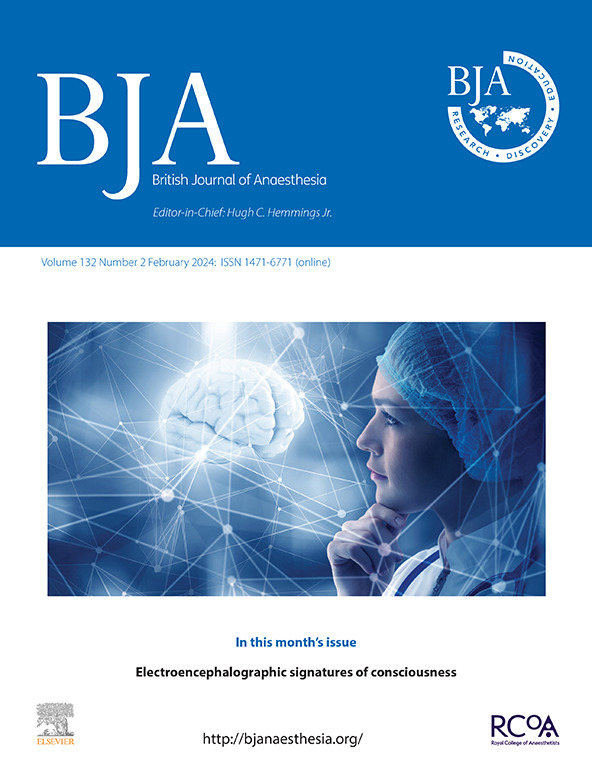Efficacy and safety of adamgammadex for reversing rocuronium-induced deep neuromuscular block: a multicentre, randomised, double-blind, positive-controlled phase III trial
IF 9.2
1区 医学
Q1 ANESTHESIOLOGY
引用次数: 0
Abstract
Background
Adamgammadex, a newly developed modified γ-cyclodextrin derivative, has demonstrated efficacy in reversing deep rocuronium-induced neuromuscular block in early clinical trials.
Methods
This multicentre, randomised, double-blind, positive-controlled, noninferiority phase III clinical trial aimed to investigate the efficacy and safety of adamagammadex compared with sugammadex in reversing deep rocuronium-induced neuromuscular block. In total, 321 patients were randomly assigned to either the adamgammadex 8 mg kg−1 group or the sugammadex 4 mg kg−1 group. The primary outcome was the success rate of antagonism, defined as recovery of the train-of-four ratio (TOFR) to 0.9 within 10 min. Standard safety data were collected throughout the trial period.
Results
For the primary efficacy outcome, the success rate for recovery of TOFR to 0.9 was 98.7% in the adamgammadex group and 100% in the sugammadex group, with an observed difference of –1.3% (95% confidence interval [CI] –4.6%, 1.2%). The lower limit of –4.6% was higher than the noninferiority margin of –10%. For the key secondary efficacy outcomes, the median (interquartile range) time from administration of adamgammadex or sugammadex to recovery of TOFR to 0.9 was 2.5 (2.0, 3.2) min and 2.2 (1.7, 2.7) min, respectively. The difference was 0.5 min (95% CI 0.3, 0.7), and the upper limit of 0.7 min was lower than the noninferiority margin of 5 min. We observed no inferiority in secondary efficacy outcomes. There was no significant difference in the safety profile between adamgammadex and sugammadex.
Conclusions
Adamgammadex was noninferior to sugammadex in reversing deep neuromuscular block from rocuronium.
Clinical trial registration
Chinese Clinical Trial Registry (ChiCTR2200056471, registered February 6, 2022; https://www.chictr.org.cn/showproj.html?proj=141077).
adamgammadex逆转罗库溴铵诱导的深度神经肌肉阻滞的有效性和安全性:一项多中心、随机、双盲、阳性对照的III期试验
背景:Adamgammadex是一种新开发的改性γ-环糊精衍生物,在早期临床试验中显示出逆转深度罗库溴铵诱导的神经肌肉阻滞的疗效。方法:这项多中心、随机、双盲、阳性对照、非劣效性的III期临床试验旨在研究adamagammadex与sugammadex在逆转深度罗库溴铵诱导的神经肌肉阻滞方面的有效性和安全性。共有321名患者被随机分配到adamgammadex 8 mg kg-1组或sugammadex 4 mg kg-1组。主要结果是拮抗成功率,定义为在10分钟内将4组比率(TOFR)恢复到0.9。在整个试验期间收集标准安全性数据。结果:主要疗效指标中,adamgammadex组TOFR恢复至0.9的成功率为98.7%,sugammadex组为100%,差异为-1.3%(95%可信区间[CI] -4.6%, 1.2%)。-4.6%的下限高于-10%的非劣效性边际。对于关键的次要疗效结果,从服用adamgammadex或sugammadex到TOFR恢复到0.9的中位时间(四分位数范围)分别为2.5 (2.0,3.2)min和2.2 (1.7,2.7)min。差异为0.5分钟(95% CI 0.3, 0.7), 0.7分钟的上限低于5分钟的非劣效性界限。我们观察到次要疗效结局没有劣效性。adamgammadex和sugammadex的安全性无显著差异。结论:Adamgammadex在逆转罗库溴铵引起的深层神经肌肉阻滞方面的效果不逊于sugammadex。临床试验注册:中国临床试验注册中心(ChiCTR2200056471,注册于2022年2月6日;https://www.chictr.org.cn/showproj.html?proj=141077)。
本文章由计算机程序翻译,如有差异,请以英文原文为准。
求助全文
约1分钟内获得全文
求助全文
来源期刊
CiteScore
13.50
自引率
7.10%
发文量
488
审稿时长
27 days
期刊介绍:
The British Journal of Anaesthesia (BJA) is a prestigious publication that covers a wide range of topics in anaesthesia, critical care medicine, pain medicine, and perioperative medicine. It aims to disseminate high-impact original research, spanning fundamental, translational, and clinical sciences, as well as clinical practice, technology, education, and training. Additionally, the journal features review articles, notable case reports, correspondence, and special articles that appeal to a broader audience.
The BJA is proudly associated with The Royal College of Anaesthetists, The College of Anaesthesiologists of Ireland, and The Hong Kong College of Anaesthesiologists. This partnership provides members of these esteemed institutions with access to not only the BJA but also its sister publication, BJA Education. It is essential to note that both journals maintain their editorial independence.
Overall, the BJA offers a diverse and comprehensive platform for anaesthetists, critical care physicians, pain specialists, and perioperative medicine practitioners to contribute and stay updated with the latest advancements in their respective fields.

 求助内容:
求助内容: 应助结果提醒方式:
应助结果提醒方式:


